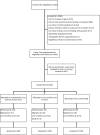Multivitamin and iron supplementation to prevent periconceptional anemia in rural tanzanian women: a randomized, controlled trial
- PMID: 25905863
- PMCID: PMC4408096
- DOI: 10.1371/journal.pone.0121552
Multivitamin and iron supplementation to prevent periconceptional anemia in rural tanzanian women: a randomized, controlled trial
Abstract
Objective: Women's nutritional status during conception and early pregnancy can influence maternal and infant outcomes. This study examined the efficacy of pre-pregnancy supplementation with iron and multivitamins to reduce the prevalence of anemia during the periconceptional period among rural Tanzanian women and adolescent girls.
Design: A double-blind, randomized controlled trial was conducted in which participants were individually randomized to receive daily oral supplements of folic acid alone, folic acid and iron, or folic acid, iron, and vitamins A, B-complex, C, and E at approximately single recommended dietary allowance (RDA) doses for six months.
Setting: Rural Rufiji District, Tanzania.
Subjects: Non-pregnant women and adolescent girls aged 15-29 years (n = 802).
Results: The study arms were comparable in demographic and socioeconomic characteristics, food security, nutritional status, pregnancy history, and compliance with the regimen (p>0.05). In total, 561 participants (70%) completed the study and were included in the intention-to-treat analysis. Hemoglobin levels were not different across treatments (median: 11.1 g/dL, Q1-Q3: 10.0-12.4 g/dL, p = 0.65). However, compared with the folic acid arm (28%), there was a significant reduction in the risk of hypochromic microcytic anemia in the folic acid and iron arm (17%, RR: 0.61, 95% CI: 0.42-0.90, p = 0.01) and the folic acid, iron, and multivitamin arm (19%, RR: 0.66, 95% CI: 0.45-0.96, p = 0.03). Inverse probability of treatment weighting (IPTW) to adjust for potential selection bias due to loss to follow-up did not materially change these results. The effect of the regimens was not modified by frequency of household meat consumption, baseline underweight status, parity, breastfeeding status, or level of compliance (in all cases, p for interaction>0.2).
Conclusions: Daily oral supplementation with iron and folic acid among women and adolescents prior to pregnancy reduces risk of anemia. The potential benefits of supplementation on the risk of periconceptional anemia and adverse pregnancy outcomes warrant investigation in larger studies.
Trial registration: ClinicalTrials.gov NCT01183572.
Conflict of interest statement
References
-
- Stoltzfus RJ, Mullany L, Black RE. Chapter 3. Iron-deficiency anemia In: Ezzati M, Lopez AD, Rodgers A, Murray CJL, editors. Comparative quantification of health risks: Global and regional burden of disease attributable to selected major risk factors. 1 Geneva: World Health Organization; 2004. p. 163–209.
-
- Bothwell TH. Iron requirements in pregnancy and strategies to meet them. American Journal of Clinical Nutrition. 2000;72:257S–64S. - PubMed
Publication types
MeSH terms
Substances
Associated data
LinkOut - more resources
Full Text Sources
Other Literature Sources
Medical


